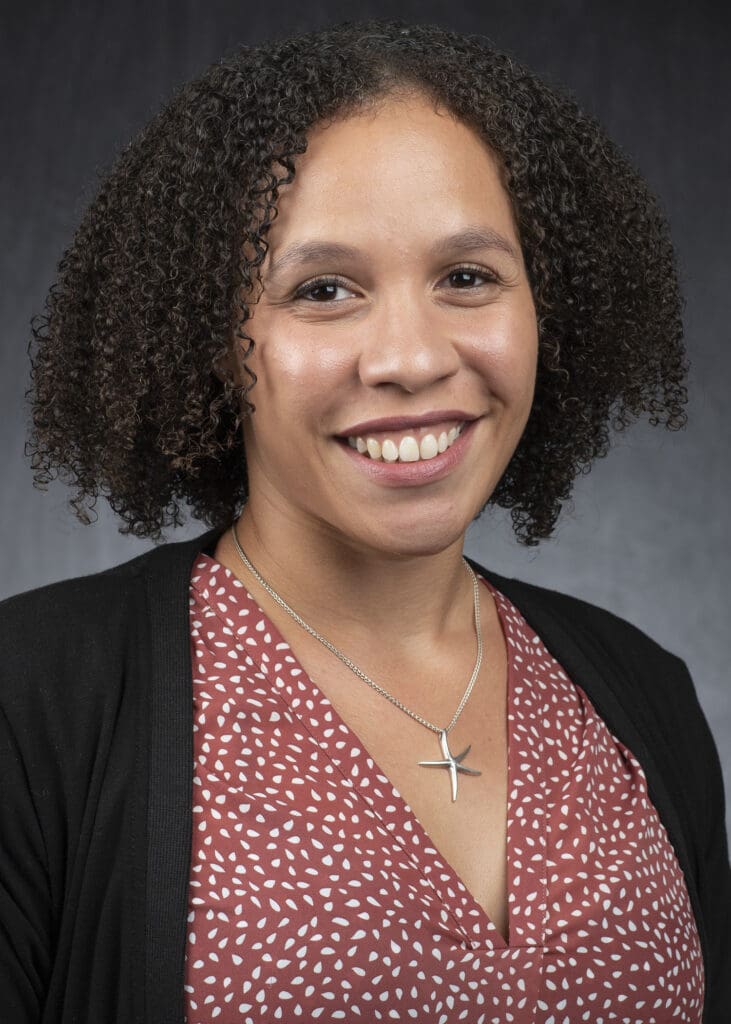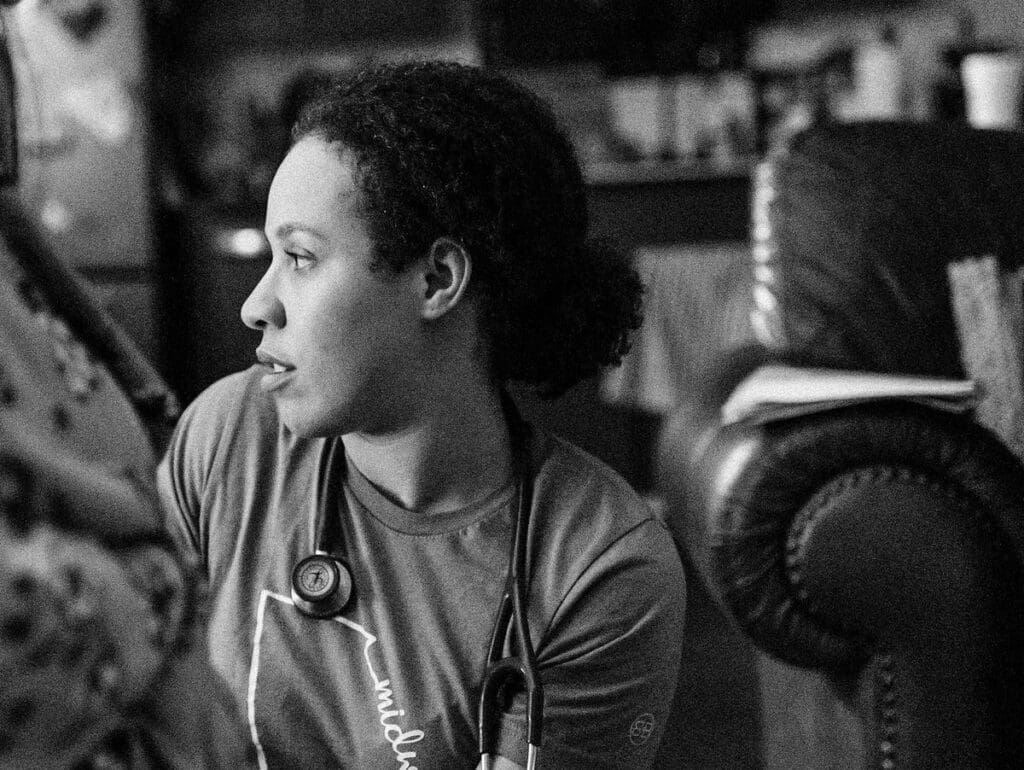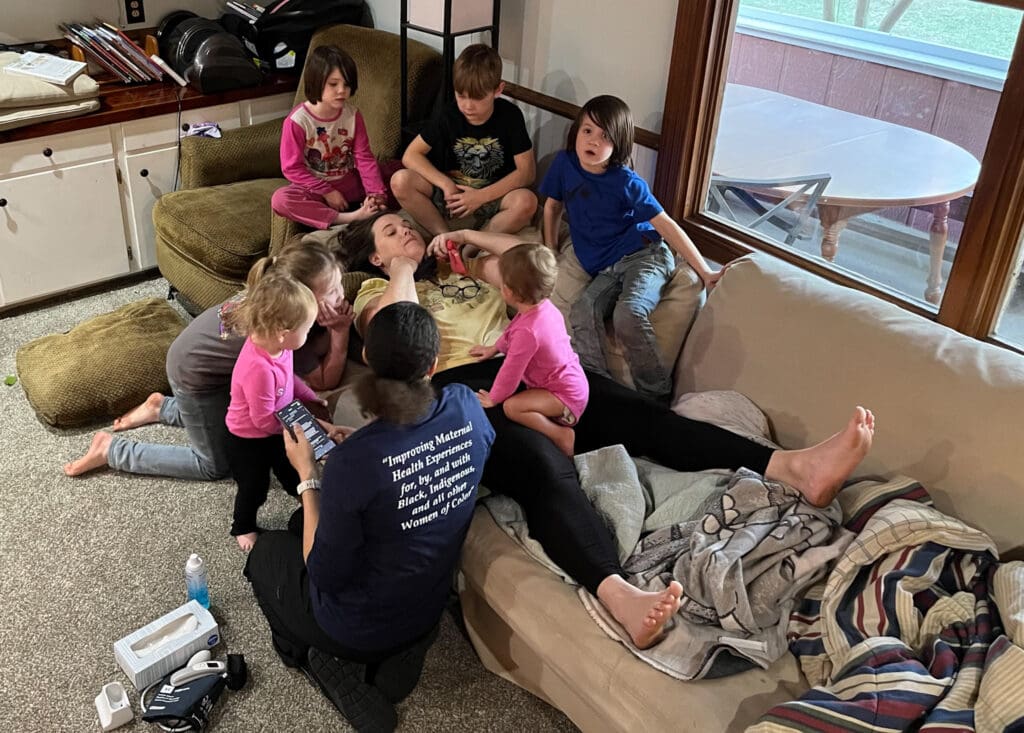This is the first post in a series called Conversations With a Midwife, spotlighting my conversation with Victoria Gordon, a certified nurse midwife, mother of six, and founder of Red Moon Midwifery. From her offices in Jacksonville, FL, St. Mary’s and Valdosta, GA, she cares for families seeking home birth, midwifery care, and holistic wellness. We talked about her journey from hospital midwifery to home birth, the realities of motherhood, and her perspective on maternal care.

Long before Victoria ever caught a baby, she carried responsibilities most people can’t imagine. As the oldest of 13 children, she was part big sister, part second mom, and at one time had legal custody of some of her younger siblings. On top of that, she was raising her own son, holding down twelve-hour shifts at Atlanta Bread Company, and attending night school four nights a week.
Her schedule was relentless: work from 6am to 6pm, walk 3 miles to school, sit in class from 7pm to 11pm, come home to care for her sisters and her baby. She got perfect attendance, the President’s Award, and made the honor roll. It wasn’t easy, but she refused to quit.
Having known her only as my knowledgable and more than capable midwife, I was surprised to learn that she didn’t just sail through school. She truly believed she wasn’t smart enough to be a nurse. Until she met Patricia, a nurse in the hospital where Victoria was working as a tech.
“She looked at me one day and said, ‘Why are you not a nurse?’
I told her, ‘Because I’m not smart enough.’
And she said, ‘That’s nonsense. If you don’t take your butt back to school and go be a nurse…’
It took her a year of talking me into it.”
By this time, she had her sisters and son to care for. Adding more school felt impossible, but eventually she did.
I was awe-struck listening to her describe that season of her life. A lesser person might have given up, but Victoria didn’t.
Burnout in the Hospital System
That perseverance carried her forward into nursing, into hospital work, and eventually into midwifery itself. After years of hard work, Victoria found herself exactly where she had once doubted she could be: caring for women in the hospital as a certified nurse midwife. But the reality of hospital-based midwifery wasn’t the kind of care she had fought so hard to give.
Victoria began her career eager to care for women and support them through birth. Instead, she found herself worn out by a system that valued speed over connection.
“They would stack my schedule with 30 people to see. I was trying to give people information about their blood pressure, heart rate, anemia, everything they came to me for, but I couldn’t do that in ten minutes. I didn’t feel like I was taking care of people…”
She explained how those ten minutes weren’t just a number; they were tied to productivity scores —a way of measuring how many patients you see, how fast.
“If you took 30 minutes with a client instead of 10, then everybody was waiting longer than they needed to be, and your productivity score would go down. You wouldn’t be making the company enough money.”
I could picture it: her rushing from one patient to the next, trying to squeeze warmth and reassurance into a system designed for speed. The very reason she became a midwife, to care for people, was being pushed aside in favor of efficiency.
And who hasn’t been the patient in this scenario? I remember vividly feeling a little whiplashed after rushed visits in the OB office where I barely had time to remember any questions I might have, much less ask them and get real answers.
Eventually, Victoria left the hospital setting altogether and began teaching at Valdosta State University.
“I loved teaching OB simulations — helping students think critically and advocate for their patients. Seeing those lightbulb moments kept me going. It was a nice break after going 100 miles an hour since nursing school.”
Teaching gave her the chance to slow down, invest in people one-on-one, and pour into the next generation of nurses. It was a different kind of care, but still deeply meaningful.
An Unexpected Call
Then, as it does, life surprised her. Through a babysitter and a series of conversations, she was asked if she would attend a home birth.
“I told her, ‘No, sorry, tell her no. I don’t do home births. I’ve never done a home birth.
I’m not that kind of midwife.’”
But they kept asking and, finally, Victoria agreed to at least talk to the mom.
“She was 35 weeks. She came prepared with her records and said, ‘There’s nothing wrong with me, I promise I’ll be an easy person.’
I called a midwife I knew who did home births and asked, ‘Should I be doing this? I don’t know what I’m doing.’
She looked over the records with me and said, ‘Yeah, you could probably pull that off.’”
With some coaching from her fellow midwife, Victoria gathered what she needed and prepared for the unknown.

Her First Home Birth
That birth was a turning point.
“She was right; she did phenomenally… I think it was probably the first time since school that I felt that happy about being a midwife. I remember just going home that night, and I was just like, ‘Wow, that was super cool...’
Obviously, not all home births are like that. And in my mind, I thought, ‘I’m not doing that again, but that was pretty cool.’ Just the once was pretty good. I’m glad I experienced that.”
Even after such a positive experience, home birth still wasn’t part of her plan.
“It wasn’t something that I ever said, ‘This is my dream.’ But I do know when I worked in the hospital, it (homebirth) never bothered me. My mom had kids at home, so I saw that growing up, and I knew that people do that… But I didn’t know what I was doing.”
I was really surprised to hear this, because for so many birth workers in the home birth world, it is the dream. And Victoria is such an incredible midwife, I thought that surely this had been a calling for a long time. But home birth midwifery had never really been part of her plan.
Sometimes life doesn’t go according to plan, but it can take us somewhere better.
Finding Purpose
One home birth led to another. Soon Victoria was attending births in bedrooms, living rooms, and kitchens.
“I could sit on their couch, sip tea, and really listen. I could spend 45 minutes, even an hour, talking through their fears, their plans, and what mattered to them without looking at the clock.”
She had time to notice the smallest details during prenatal visits. A client shifting uncomfortably when certain topics came up. The tone of her voice changing. Her face lighting up when she imagined holding her baby. The way she leaned forward or looked away told Victoria something about what was on a Mom’s heart.

“I didn’t have to say, ‘Well, I can’t let you do that or I’ll get fired.’
I could say, ‘Okay, let’s talk about what’s safest for you, and what you want.’
That’s huge.”
This is the kind of care every person wants. To feel heard, listened to, and have your needs and wants valued.
Home birth wasn’t just a change of scenery, it was a return to the kind of midwifery and care she’d imagined at the start of her career.
Reclaiming Her Calling
Leaving the hospital gave Victoria back her “why.”
“I got into this to take care of people, not just to manage them through a process. Home birth let me be present again, to witness families stepping into parenthood on their own terms.”
Her journey is a reminder that the setting of your birth doesn’t just shape your experience, it can also shape the kind of care you receive. And sometimes, the right environment changes everything. For both the family and the person caring for them.
Just the Beginning
Victoria’s story of rediscovering her purpose is just one piece of a larger picture. In the next part of Conversations With a Midwife, we talk about the state of maternal care in Georgia, why so many families are questioning hospital birth, and what’s leading more women to seek out home birth as an alternative.
You might also like:
comments +